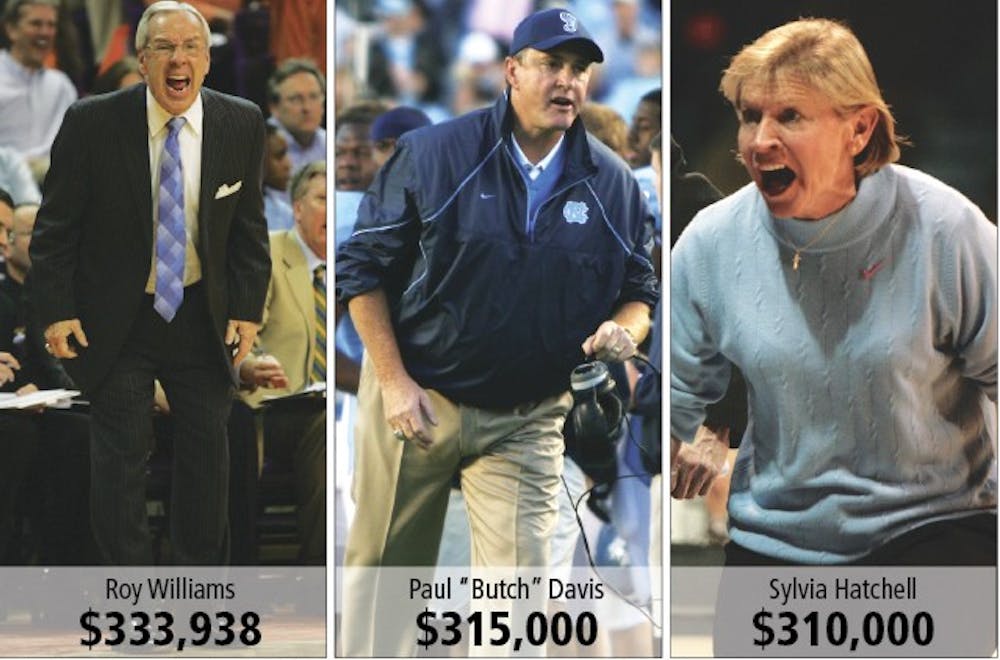All of these numbers underscore a surprising point — even though UNC routinely finishes in the top 10 nationally in the Directors’ Cup, a composite measure of each school’s success in selected sports, it does it without a top 10 budget.
Stanford, which has won the Directors’ Cup in each of the last 16 years, ranks third among all BCS teams in coach spending. The only team in the top 10 of the Directors’ Cup with a lower coaching budget than UNC is UCLA.
“My general impression is that across the board, our salaries are lower than our competitors,” Baddour said. “That is for head coaches, assistant coaches, administrators. There are certainly exceptions to that, but across the board, for the level of achievement, we are at best average and often, more than not, below average.
“I would say it is remarkable what we’re doing with our operating budgets and our coaching staffs, absolutely.”
The smaller budget means that the pressure is on Baddour and Co. to make lasting hires the first time.
But as strong as the pull is for coaches to go to other programs, there is also a strong pull to stay.
Women’s soccer head coach Anson Dorrance used to feel that it was his job to get his assistants head coaching jobs elsewhere — until he discovered they didn’t want to go anywhere else.
“I remember one time years ago a really good position opened up, and I started making calls for (assistant Bill Palladino),” Dorrance said. “He comes into my office and says, ‘Anson, do you want me to leave?’ I said, ‘No.’ And he said ‘Well I don’t want to leave.’ And that was it.”
UNC’s athletic department maintains a low budget because it has to — it is insulated in its cash flows, both public and private.
UNC and most other public universities do not use the state’s money in their athletic departments’ budgets. Baddour said the budget cuts that are sweeping through the University do not affect coach salaries.
Coach salaries come from the general revenue fund of the athletic department itself.
“Coaches’ salaries come from …ticket sales, TV, student fees, it’s everything that we do,” Baddour said. “That goes into the general revenue fund, then coaches’ salaries, travel budgets, recruiting budgets come out of that fund.
To get the day's news and headlines in your inbox each morning, sign up for our email newsletters.
“But we are in a very difficult financial situation right now,” Baddour said. “We’ve had to reduce our budgets. We’ve done that on the administrative side, we’ve not cut sport budgets at this point.”
UNC’s athletic department made $238,644 in profit, while earning $67,613,805 in revenue in the 2009-10 school year.
Despite paying for student-athlete scholarships, UNC’s Rams Club booster organization remains independent of the coaching side of the athletics department.
“I can’t speak for each individual school, but for the most part (booster clubs’) main purpose is scholarships, or if it’s not scholarships, it’s raising money for operating budgets and facilities,” Rams Club executive director John Montgomery said.
It is commonplace for booster clubs to have very little influence in personnel matters, as the athletic department strives for total autonomy in that regard. The only way Rams Club money spills into the athletic program is from the sport’s individual endowment held by the booster club.
“There are sport endowments that the Rams Club holds, and the income off of those endowments for each sport,” said Martina Ballen, senior associate athletic director for business. “They can’t touch the principal, but the interest off of it is given to us, and that is put into an account for (each specific sport).”
Despite the “difficult financial situation,” Baddour does not foresee a situation where newly vacant coaching spots go unfilled or cut altogether.
“Anything is possible, but that would be the last place we would look,” Baddour said. “Assistant coaches would be the very last place we would look. That would be the same to us as cutting faculty. We would look to every other situation to cut budgets than to eliminate positions.”
Contact the Sports Editor at sports@dailytarheel.com.



